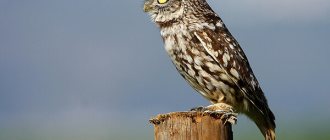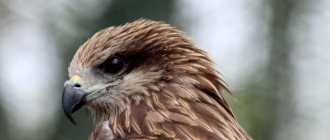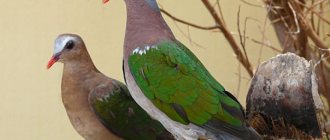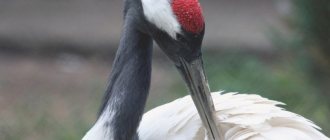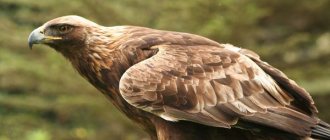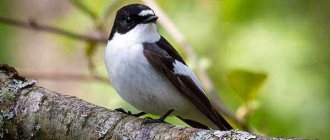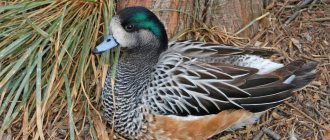- Wild animals
- >>
- Birds
The great owl is one of the smallest representatives of the owl family that lives in Europe and the Urals. It is sometimes popularly called an owl or a sparrow owl. These names are directly related to the fact that the size of the bird is almost similar to the size of a large sparrow. However, despite its diminutiveness and even some cuteness, the pygmy owl is a feathered predator.
Origin of the species and description
Photo: Great Owl
The pygmy owl (Glaucidium passerinum) is a species of birds of prey, which in ornithology belongs to the order “Owls” and the family “Owls”. This is one of the smallest owls with a body length of up to 16 cm, a weight of up to 100 g and a wingspan of up to 40 cm. Males and females of these birds look almost the same, except for the difference in size: females are slightly larger. The facial disc, unlike ordinary owls, is not very pronounced in sparrow owls.
Video: Great Owl
The feathers on the upper part of the body of adult birds are grayish-brown, less often brown. The tail feathers on the wings have a noticeable white pattern, and small white feathers are scattered throughout the owl's body. The underside of the pygmy owl's body is light, almost white, with noticeable brown stripes. A darker spot mottled with small white spots is clearly visible on its chest and crop.
The tail, depending on the overall color, is brown or gray. Regardless of the general color of the plumage, the owl's tail has five long light stripes. Young birds of the first year of life are noticeably different in appearance from adults in the absence of white inclusions in the plumage on the head, as well as a duller brown or gray color of the rest of the plumage.
Distribution area
The pygmy owl and the horned owl are birds that attract people as pets. They have virtually the same sizes and lifestyles, they have the same maintenance requirements, but their distribution area is different. The great-footed owl lives in eastern North America, while the passerine owl lives in Eurasia.
A notable feature is that Glaucidium passerinum is distributed over a very narrow band from Japan to Scandinavia. The habitat is focused on forest and taiga areas. In the Urals, its existence is intertwined with two other small species of owls - the little owl and the Scops Owl. But they cannot be called permanent neighbors.
For the great owl, ideal habitat conditions are forest areas where trees with tall trunks are planted. Spruce trees are also typical for bird distribution. In short, if the forest is mixed, then most likely you can find the small owl in question here.
Appearance and features
Photo: What a pygmy owl looks like
The pygmy owl is very characterized by its densely spotted plumage, which is much less typical of its other relatives. Moreover, the color of the birds is the same regardless of the gender of the birds.
The upper part of their body is, as a rule, gray or gray-brown with frequent small white patches, and the lower part is white with clearly distinguishable longitudinal stripes of brown color. There are also numerous white spots on the owl's head, but there are many more of them on the back. The birds have a darker patch on their chest with small white markings.
The pygmy owl's head is not too large, round, slightly flattened with a bright yellow small curved beak. The facial disc of the species is barely noticeable, and the feathered ears, characteristic of all owls, are completely absent. The birds have medium-sized eyes, with a bright yellow iris (almost identical in color to the beak) and dark pupils framed by subtle, blurry brown and white circles.
Quite thick light “eyebrows” literally hang low over the eyes, giving the bird a very stern and stern appearance. The paws of the pygmy owl are feathered, quite thickly and almost right down to the claws. Very sharp, long, strong, curved claws are present on all four fingers.
Where does the great owl live?
Photo: Great owl in Russia
In the natural environment, the great owl is most common in Europe and Asia, up to the Arctic Circle, but most often it can be observed in the countries of Central and Eastern Europe and Scandinavia. On the territory of Russia, birds are found in fairly vast areas from Sakhalin Island (in the east) to the Kola Peninsula (in the north). The pygmy owl is also very widespread in Transbaikalia, Altai, and Manchuria. This species is also found in Belarus, but quite rarely.
These birds are considered sedentary, but in very harsh winters and with a lack of food, they can migrate en masse from northern regions to more southern ones and remain there until spring. For life, pygmy owls most often choose very dense coniferous forests (mainly old, dense spruce forests) or equally dense, almost impenetrable mixed forests with a predominance of coniferous species.
Interesting fact: Each owl has its own personal hunting grounds, which can be of different sizes in different seasons: in summer - 500 sq. meters, and in winter - 1000 sq. meters.
Birds usually build their nests in the hollows of coniferous trees (pine, spruce), sometimes birch, aspen or beech, where woodpeckers, squirrels or other owls used to live. The main requirement for the dwelling is that the hollow itself and the entrance hole in it must be small so that predators cannot get there and destroy the nest.
Now you know where the pygmy owl lives. Let's see what he eats.
What does the pygmy owl eat?
Photo: Great Owl
As already mentioned, pygmy owls are predators, so they feed exclusively on animal food. Their diet depends on the season. For example, in summer and autumn they catch various small mouse-like rodents.
In winter and early spring, the diet of owls is dominated by small passerine birds:
- sparrows;
- tits;
- bullfinches;
- nuthatches.
It is worth noting that, unlike its larger relatives, the pygmy owl, having caught prey, does not swallow it whole, but savors it for a long time, carefully plucking out small pieces. At the same time, he tries to choose the most delicious and never touches the intestines.
Interesting fact: Great owls often store food for future use. They do this in cold weather, at sub-zero air temperatures, and hide their reserves in old uninhabited hollows.
In relation to their hunting area, birds are distinguished by enviable constancy and can leave it only in winter, when the number of small animals in the forest decreases significantly. For this reason, during the winter months, pygmy owls are quite often found on the outskirts of small towns and villages. There they hunt sparrows and thus wait out the unfavorable period.
Diet of a small predator and photo
The pygmy owl is a full-fledged predator. Although its small size does not allow it to take aim at large prey, the owl’s diet is quite abundant and varied, and its hunting grounds are vast (up to 4 sq. km.). The poultry menu includes:
- small birds;
- rats;
- mice;
- lemmings;
- hamsters, etc.
When there is enough food, the owl displays the habits of a notorious gourmet: the contents of the victim's head are eaten, and the rest is generously left to other inhabitants of the forest.
These miniature winged creatures are thrifty. They prefer to meet winter fully prepared, making supplies ahead of time.
Features of character and lifestyle
Photo: Great owl in nature
The pygmy owl is most active at dawn or in the evening twilight, and less often during the day. Unlike their shy and mistrustful relatives, this species of owl is quite inquisitive. Moreover, their curiosity is so obvious that owls are practically not afraid of either people or dogs and can fly quite close to them - at a distance of up to 5 meters. Sitting close on a branch, the pygmy owl usually examines the object of its curiosity for a very long time, twitching its tail.
Owls fly quickly and easily, flying about 30 meters in one pass, sometimes fluttering back and forth for short distances. At the same time, they demonstrate maneuverability and dexterity. Birds prefer to wait for their prey while sitting on a branch of a tree. Having noticed the prey, they quickly take off and grab it with their tenacious claws. It has been noted that, unlike other owls, sparrow owls even sometimes engage in stalking. Also, owls are not at all averse to hunting near bird feeders, because there is nothing easier than catching a tit or sparrow while feeding.
Interesting fact: Sparrow owls are, in a sense, food gourmets. This is manifested by the fact that having caught a small bird or mouse, the birds first carefully remove feathers or wool from the carcass, and only then start eating. It often happens that they eat only the head of caught prey.
In late autumn or early spring, birds often stock up on food, dragging their prey into some hollow for storage. It was estimated that just one “pantry” could store several dozen carcasses of mice or small birds. By the way, it is not difficult to find the pygmy owl’s “closet” - it is revealed by a lot of food remains at the foot of the tree.
Unlike other birds that nest in hollows, the pygmy owl also does not worry too much about camouflaging its home and unmasks it, every now and then throwing out its scraps and shells from there after the chicks hatch.
Social structure and reproduction
Photo: Great Owl in winter
Great owls (both females and males) reach sexual maturity at the age of 1 year. The mating season for pygmy owls usually lasts from February to May. At this time, males tend to attract the attention of females with characteristic whistling trills. They usually whistle at dusk, but if the weather is cloudy, then during the day. The peak of “love serenades” falls in April, and owls’ evening songs are louder than daytime or morning songs. The voice of pygmy owls is very similar to the chirping of sparrows.
The process of introducing a male to a “bride” in owls begins with the male demonstrating his home - a hollow. If the female is satisfied with the home, then she remains there and thus a new married couple is created. Owls form pairs for life. Since males are usually very attached to their hunting area, their nesting site does not change for several years in a row.
Before starting their life together, the couple does a thorough cleaning of the hollow. The number of eggs in a clutch depends on the abundance of food. Under favorable conditions, this can be 5-7 eggs; if there are problems with obtaining food, then only 2-3 eggs. Eggs are laid at intervals of a couple of days. They are usually almost round, white, up to 25 mm in diameter.
A pair of owls hatches a clutch for a month. In this case, the female sits in the nest, and the male first provides food for her and then for the chicks. The chicks are not born together, but one at a time. They are covered with light fluff. For the first 8-10 days, the female does not leave the nest, warming the chicks.
Interesting fact: Sitting on the nest, the female gradually expands it, picking out pieces of wood and throwing them out.
After 3 weeks, the chicks begin to look out of the hollow. Parents fly to them every now and then to feed or clean the nest. The chicks feed first on insects and their larvae, and then on small rodents. Gradually, the fluff on the body of the chicks is replaced by plumage, the same as that of the parents, only in darker shades. A month and a half after birth, the young owls leave the nest and become completely independent.
Nutrition
In order to get food for themselves, owls have to hunt. At the same time, they act in pairs and harmoniously. Owls can thus easily defeat gray rats, which are famous for their incredibly evil character.
An important feature of these birds is that they hunt underground. Therefore, it is very difficult for gerbils to escape from them.
Underground hunting sometimes has a negative impact on the condition of bird feathers. They can be combed in the area of the head and back. Sometimes, instead of them, owls simply have needles sticking out.
The bird menu is very diverse. Its changes occur due to the taste of birds and the presence of one or another prey. For some owls, their favorite food is dung beetles. Others get incredible pleasure from eating mice, while others prefer phalanx spiders.
Natural enemies of pygmy owls
Photo: What a pygmy owl looks like
Although pygmy owls are predators, they have many natural enemies. This is due to their innate curiosity and almost complete lack of caution as such. Curious birds can be hunted by foxes and wolves, as well as some representatives of felines and mustelids. Yes, if the bird was scared at least once, then in the future it will become more careful (of course, if it survives).
The nests of Great Owls, their eggs and chicks are even less safe. As you know, birds nest in the hollows of old trees, and it happens that the hole in the hollow (entrance hole) is large enough for any predator, be it a larger owl, owl or marten, to easily crawl into it. In addition, squirrels often sin by destroying bird nests, willingly eating eggs.
Interesting fact: Great owl chicks leave their parent's nest at the same time. When the chicks first fly out of the nest, the parents are always nearby to help. At first the chicks fly ten meters, and then more and more.
Chicks that have barely fledged are also under considerable threat. After all, at first they are not good flyers. This is where they can be caught by a fox, marten or lynx. Yes, the parents of the chicks are always nearby, but in the event of an attack by a larger predator, they will not be able to help the chicks in any way. To be honest, man himself is also an enemy for birds, due to his activities and great desire to establish his own order everywhere.
Common diseases
There are many diseases that the pygmy owl catches. The sparrow owl has been susceptible to diseases since childhood, and many of them appear in babies with the condition that even maternal care will not help get rid of them.
If a healthy and adult individual suddenly begins to refuse to play and eat, this means that there is an infection in the body. Since the bird is rare, you should immediately contact a veterinarian. If the disease is common, then the doctor will quickly be able to identify it, as well as prescribe a recovery algorithm. If he was previously unfamiliar with her, then only immunity will help him become healthy again.
As a rule, birds at home get sick more often only because they are not kept correctly. For example, they can be fed those grains or fruits that are contraindicated for them or allowed, but in small quantities. In addition, if the food is expired or spoiled, then it is necessary to purchase new ones - owners rarely monitor this.
